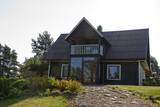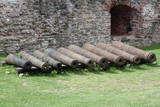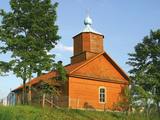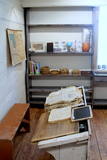| Nr | Nosaukums | Apraksts |
|---|---|---|
|
Maršruts veidots pa ainaviskākajām Igaunijas dabas teritorijām – Monzunda biosfēras rezervātu, Matsalu nacionālo parku un Viidumäe rezervātu. Tas ietver divas dabas un kultūras pieminekļiem bagātākās un lielākās Igaunijas salas – Saaremaa un Hiiumaa, kā arī mazās Muhu un Kasari salas. Maršrutā iekļautas interesantākās dabas takas (garums 1 – 5 km), skatu torņi un putnu vērošanas vietas, ainavas un biotopi, kā arī trīs braucieni ar prāmjiem starp Monzunda arhipelāga salām. |
||
|
Ciemos gaidīti gan pāri, gan ģimenes, gan draugu kompānijas. Lauku sēta sastāv no piecām ēkām. Neskartā daba un tīrais gaiss ļaus atpūsties pilnīgā klusumā. Ap 50 m no Šventosios (Svētās) upes atrodas galvenā ēka, kurā ir divas guļamistabas ar tualeti un dušu nakšņošanai līdz 10 personām. Pirts namiņš būs ērts draugu lokam līdz 9 cilvēkiem. Pieejami trīs jauni VIP namiņi 2-4 cilvēkiem upes krastā. Piemērota vieta kāzu, dzimšanas dienu u.c. svinībām. |
||
|
Garš ciems abpus Lūžņas upei. 1937. g. te bija 36 mājas un 2 laivu piestātnes. 19. gs. 60. gados Lūžņa kļuva par vienu no kuģubūves vietām, bet padomju okupācijas gados tuvumā atradās militārās bāzes. 20. gs. 30. gados te vairākkārt ieradās somu valodnieks Lauri Ketunens ar igauņu studentu Oskaru Loritsu, kuri sagatavoja lībiešu valodas vārdnīcu. Lūžņā dzīvoja pirmais lībiešu mākslinieks Jānis Belte (1893 - 1946). Lūžņas lībiešu zvejnieka un zemkopja sēta “Dēliņi” apskatāma Latvijas Etnogrāfiskajā brīvdabas muzejā. |
||
|
No Bauskas pils pagalmā redzamiem lielgabaliem neviens nav atrasts pilī, bet ir nākuši no dažādākām Zemgales vietām. Četri lielākie lielgabali, kas ir labāk saglabājušies čuguna lielgabali Latvijā ir nākuši no Jaunsvirlaukas puses un atrasti Lielupes krastā iepretim Emburgai. Pagaidām vienīgais pilī atrastais lielgabals atrodas pils Dienvidaustrumu tornī un apskatāms izstādē par pils militāro vēsturi. Vai kāds no lielgabaliem ir piedalījies kādā no kaujām grūti spriest. Bauskas pilī atrastais lielgabals atrasts pielādēts, no tā stobra tā tīrīšanas laikā ir izvilktas divas lielgabala lodes un cik vēl tur iekšā nav zināms. Šobrīd Bauskas pilī atrodas Latvijā lielākā lielgabalu kolekcija.
|
||
|
Cesvaines vārds rakstiskajos avotos pirmoreiz minēts 1209. g. Pilsēta ikvienam Latvijas apceļotājam saistās ar baronu Vulfu dzimtu, kas 1815. g. iegādājās Cesvaines muižu. Cesvaines ekonomiskais uzplaukums pēc Pļaviņas-Gulbenes dzelzceļa izveides. Pilsēta cieta 2. Pasaules kara laikā. 2002. g. beigās Cesvaines pils skāra traģēdija – ugunsgrēks, kura laikā cieta lielākā pils daļa. Pēc liela sabiedrības, valsts un pašvaldības atbalsta Cesvaines pils „atgūstas" un joprojām saglabā Vidzemes un Latvijas mēroga tūrisma objekta statusu. |
||
|
Kuģītis "Baltā Kaza" vizina tūristus pa Daugavu un darbojas arī kā pārceltuve no Jaunjelgavas uz Skrīveriem. Vasaras sezonā kursē regulāros laikos. Iespējamas arī ekskursijas un izbraucieni līdz Mīlestības saliņai, Aizkraukles pilsdrupām, Ķeguma HES u.c. Iespējami arī citi maršruti. 25 pasažieru vietas. Braucienu laikā var iepazīties ar Daugavas abu krastu kultūrvēsturisko, vēsturisko, bioloģisko objektu stāstījumu. Ķuģīša īpašnieks rīko pasākumus, koncertus gan uz Daugavas, gan Daugavas krastā. Piestātnē iespēja iznomāt SUP dēļus, airu un kanoe laivas, katamarānus. |
||
|
Spriņģu pilskalns (Golberova gora) atrodas Rēzeknes pilsētas
pievārtē un interesants ar savu īpatnējo veidolu. Valsts nozīmes arheoloģijas
piemineklis.
|
||
|
Ainaviskā plāna Joniškeļo muižas parks izveidots 18.gs. otrajā pusē. 19.gs. sākumā pārveidots un paplašināts. Cauri parkam tek Mažupe. No muižas ciematiņa puses abās pusēs gājēju taciņai stiepjas liepu aleja. Muižas priekšā – liels laukums. Parkā aug pāri pat 20 šķirņu vietējo koku un krūmu, un vairāk kā 30 šķirņu un formu introducentu. Ievērojamas un vērtīgas ir divas parastās jeb “čūskas zaru” formas egles, savdabīga parastā ligzdas formas egle. Tāpat šalc Lietuvā diezgan reti sastopamās rietumu zelta tūjas, parastais dažādlapu ozols, divstumbru sudrabkļava, pelēkais riekstkoks. Parkā viz trīs dīķi. |
||
|
~ 6000 taksonu, tai skaitā gandrīz 300 dāliju šķirnes, 120 acāliju un 100 āra rododendru šķirnes.
Augu mājās aug dažādi eksotiski tropu augi un to augļi (tai skaitā, citroni, banāni, ananāsi, vīģes, olīvas, avokado un kafija), plaša kaktusu kolekcija un lielākā Latvijas palmu kolekcija. Āra ekspozīcijās apskatāmi gan bagātīgi ziemciešu stādījumi, gan ārstniecības augi un Latvijas indīgo augu kolekcija, kā arī augu sistemātiskās grupas (raksturīgas vienīgi universitāšu botāniskajiem dārziem). Vienīgā vieta Latvijā, kur pavasarī vienviet redzams tik daudz ziedošu magnoliju.
Āra ekspozīcijās – ēdamā kastaņa (Castanea sativa), ginks (Ginkgo biloba), reliktā metasekvoja (Metasequoia glyptostroboides), baltais zīdkoks (Morus alba), trīsdaivu dižmandele (Louiseania triloba), karaliskais grieķu valrieksts (Juglans regia). Augu mājās – araukārijas (Araucaria bidwillii un A. heterophylla), volēmija (Wollemia nobilis), liellapu gumijkoks (Ficus macrophylla), karaliskā Viktorija (Victoria regia) u.c.
|
||
|
Atrodas Jēkabpils dienviddaļā – tirdzniecības centrā „Aura”. Lauku vides noskaņā veidotas omulīgas telpas, kur piedāvā maltītes visām ēdienreizēm. |
||
|
Lipušku apkārtnē jau no seniem laikiem apmetušies vecticībnieki (lielākā draudze Baltijā). To lūgšanu namu cēla 1893. gadā. Tas daudzkārt cieta no laupītājiem, tādēļ ēkas iekšpusē izvietoja ikonu fotokopijas. Līdz 1905. gadam dievnamus varēja celt tikai tādus, lai tie no ārienes neatšķirtos no parastas dzīvojamās mājas - tiem nebija zvanu, krustu un kupolu. Likumsakarīgi - arī Lipušku lūgšanu namu cēla kā dzīvojamo ēku. Kad par to uzzināja vietējā vara, to gribēja slēgt, taču vecticībnieki blakus ikonām novietoja carienes attēlu, kas nodrošināja turpmāku tā pastāvēšanu. Apskatāms no ārpuses. |
||
|
Viesu namā var apskatīt viesu nama lepnumu – pagrabu –, kurā atrodas liela saimniecībā gatavoto vīnu kolekcija. Saimniecībā var iegādāties ābolu, vīnogu, ķiršu, upeņu, dzērveņu, ērkšķogu un rabarberu vīnu. |
||
|
SIA “Rundāles Dzirnavas” 2021. gadā īstenoja projektu, lai izveidotu nelielu alus darītavu un uzsāktu alus ražošanu Rundāles ūdensdzirnavu teritorijā. Tiek ražots gaišais un tumšais alu, kura visas sastāvdaļas tiek iepirktas Latvijā, bet graudi no vietējiem zemniekiem. Videi draudzīgā iekārta atbilst jaunākajiem ES standartiem un prasībām. Latvijas un ārvalstu tūristiem ir iespēja apvienot Rundāles pils apskati ar vēsturisko dzirnavu muzeja un alus darītavas apmeklējumu. Kompleksa teritorijā ir daudz iespēju daudzveidīgai interesantai laika pavadīšanai. Vienas dienas laikā var apmeklēt aizraujošas ekskursijas pa dzirnavām un alus darītavu, pastaigāties pa vietējiem, tuvējiem apskates objektiem, uzņemt lieliskas fotogrāfijas, atpūsties pludmalē un vizināties ar laivu, katamarānu, SUP dēli. |
||
|
Žagares muižas parks – viens no krāšņākajiem un arhitektūras ziņā interesantākajiem parkiem Lietuvā. Muižas parks 1898. – 1900. gadā rekonstruēts un paplašināts pēc ievērojamā dendrologa G.F.Kuphalda projekta. Parkā iestādīti vairāk kā 200 šķirņu stādu. Vairāk kā 100 no tiem aug vēl joprojām. Parkā līdz šim saglabājušies dažādi ceļi, takas, par kurām staigājot var izjust parka varenību un skaistumu. Parkā izveidota dendroloģiska taka, kurā atzīmēta un piedāvāta informācija par 15 retiem kokiem. |
||
|
Alus darbnīca un tirgotava "Pumpurs" Lielvārdē izveidota 2017. gadā, pirms tam labu laiku attīstot zināšanas un prasmes un savas receptes brūvējot citās alus darītavās. Katru gadu tiek brūvētas līdz 10 dažādas alus stilu garšas, kuras iespējams iegādāties gan uz vietas tirgotavā, gan dažādās tirdzniecības vietās tuvākajā apkārtnē un Rīgā. Rīko ekskursijas un degustācijas, lai izzinātu vairāk par alus brūvēšanas procesu un alus stiliem, to garšu īpatnībām. Iespējams iegādāties arī dažādus citus Latvijā ražotus gardumus. |
||
|
Dienvidigaunijā skaistā Pühajärve ezera krastā esošajā restorānā varēsiet nobaudīt šefpavāra gatavotos pirmklasīgos ēdienus. Pārsvarā tiek izmantotas svaigas vietējās izejvielas. Tiek arī organizēti īpaši kulinārijas pasākumi. |
||
|
Jūrkalnes bibliotēkas otrajā stāvā ir izvietoti Jūrkalnes un suitu tradicionālie vēstures priekšmeti un vairākas stelles, kur vietējie cilvēki organizē radošās darbnīcās. Interesenti, iepriekš piesakoties, var noklausīties gida stāstījumu par suitu kultūru un tradīcijām, kā arī noskatīties filmu. |
||
|
This route will allow you to see Latvia's most impressive medieval castles or their ruins, as well as outstanding manor houses from aristocratic estates dating back th the 18th and 19th century. The mansion of the Ungurmuiža Estate is one of the only wooden palaces left in Latvia from those that were built in the early 18th century. The ruins of the Cēsis Castle are among the most impressive Medieval ruins in the country. The tower of the Turaida Castle offers panoramic view of the ancient Gauja River Valley. About one-half of the route passes through the Gauja National Park. You will arrive at the place where the oldest crossing of the Baltic rivers exists - the rafts which transport people across the river are still powered by the stream itself. |
||
|
Saimniecība atrodas tradicionālajā zvejnieku ciematā, un šeit ir cieņā vietējie ēdieni un rokdarbi. Viesiem tiek piedāvāts degustēt pašgatavotos produktus, kā arī šeit rīko ēdiena gatavošanas un amatniecības meistarklases un iepazīstina ar lauku dzīvi. |
||
|
Vieta, kur 1. pasaules kara laikā 1916. g. notika t.s. Ziemassvētku kaujas starp Krievijas un Vācijas karaspēku, pēc kurām latviešu strēlnieku drosme un varonība aizskanēja tālu pāri valsts robežām. Ložmetējkalnā ir izveidota piemiņas vieta latviešu strēlniekiem un atjaunots skatu tornis. No tā labi redzams Maztīreļa purvs ar bijušo vācu šaursliežu dzelzceļa līnijas vietu, kas to šķērso ziemeļu - dienvidu virzienā, iezīmējot purvā lielāku koku rindu. Kā iepazīt? Iespēja doties pārgājienos gan ar gidu, gan bez, apmeklēt Ziemassvētku kauju muzeja "Mangaļu" māju, kuras apkaimē izveidots marķēts izziņas maršruts, piedalīties tematiski izglītojošos pasākumos un kauju imitācijās. Apskatāmi pieminekļi, karavīru kapi, ierakumi, fortifikācijas, zemnīcas u.c. Mangaļu mājās atrodas Latvijā lielākais kauju vietu makets. Apskatāmi Baltijas reģionam unikāli 1. pasaules kara lauka fortifikācijas elementi, kas saistīti ar leģendārajām Ziemassvētku kaujām: autentiskā vietā rekonstruēts nocietinājumu sistēmas posms – blindāža un daļa no vācu aizsardzības pirmās līnijas t.s. „Vācu valnis”. |
||



























